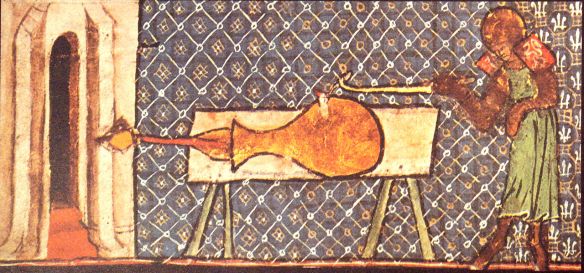
A pot-de-fer, as shown by the Millimete manuscript.
Bell-shaped, primitive gunpowder artillery. They were cast by bell makers. Because they were fired from a ground board rather than a stabilizing gun carriage, they were wildly inaccurate.
The pot-de-fer was first depicted in a manuscript, De officiis regum of 1326, by Walter de Millimete, an illuminated manuscript of 1327 that was presented to Edward III upon his accession to the English throne. The manuscript shows a large vase lying on a table, with an armored man behind it holding a rudimentary linstock near the bottom (in this case the linstock would have held a red-hot wire, heated in a brazier, rather than a slow match). A bolt, called a garrot, protrudes from the muzzle. Although illustrated in the treatise, no explanation or description was given.
The pot-de-fer was used by the French in the Hundred Years’ War in a raid on Southampton and in battles in Périgord, Cambrai, and Quesnoy. They may also have been used against the Scottish by the English.
An early reference to the name in French is as pot de fer a traire garros (an iron jug for throwing arrows). Such a ‘pot de fer’ had a bottle shape, which may have suggested its name.
Contemporary etchings and descriptions suggest that they shot thick arrows wrapped in leather to fit the mouth of the vase and seal in propellant gasses. The powder was placed in the rounded end and touched off by a heated wire or match. These weapons were unreliable and probably served as little more than noisemakers. There is a record from 1338 suggesting that the French used pots de fer from ships, an extraordinarily risky tactic, during a raid on the English coast. Once it became possible to manufacture large cannon with the hoop-and-stave method the term pots de fer shifted in meaning to refer to pre-loaded breeches or pots that contained the charge, wadding, and cannonball inserted as one into breechloading bombards. Neither sense should be confused with a still later incendiary sometimes also called a “firepot.”
alcancia. “firepots.”
Small incendiaries that were thrown like hand grenades during ship-to-ship close fighting. They were in use in most navies into the late 16th century. Not to be confused with the earlier pots des fer.